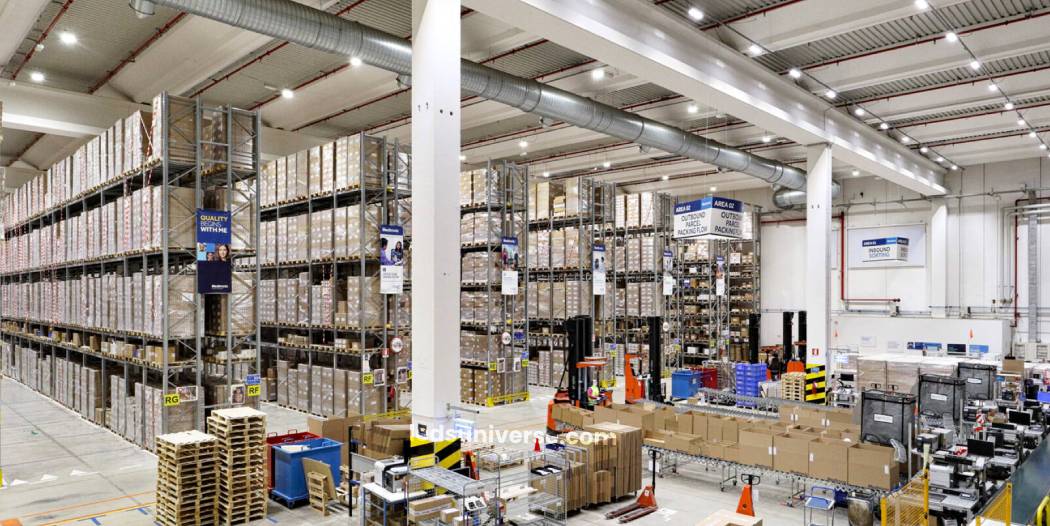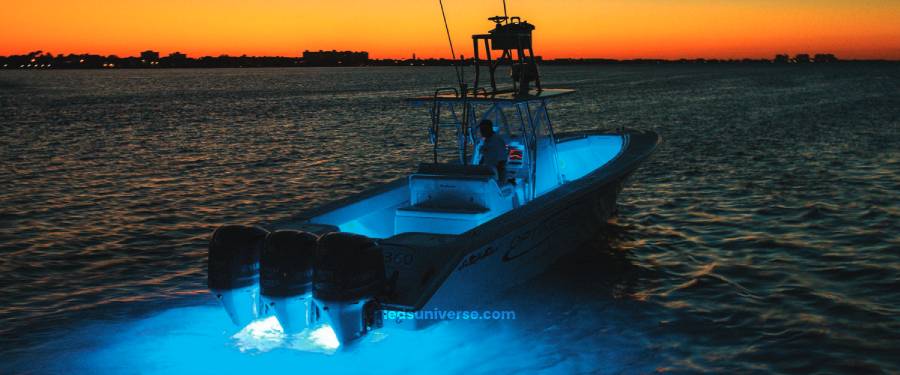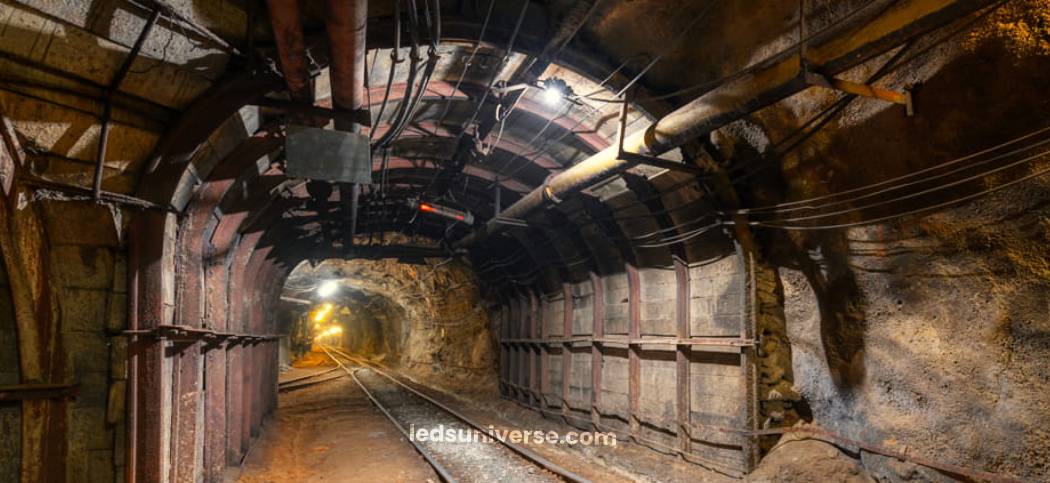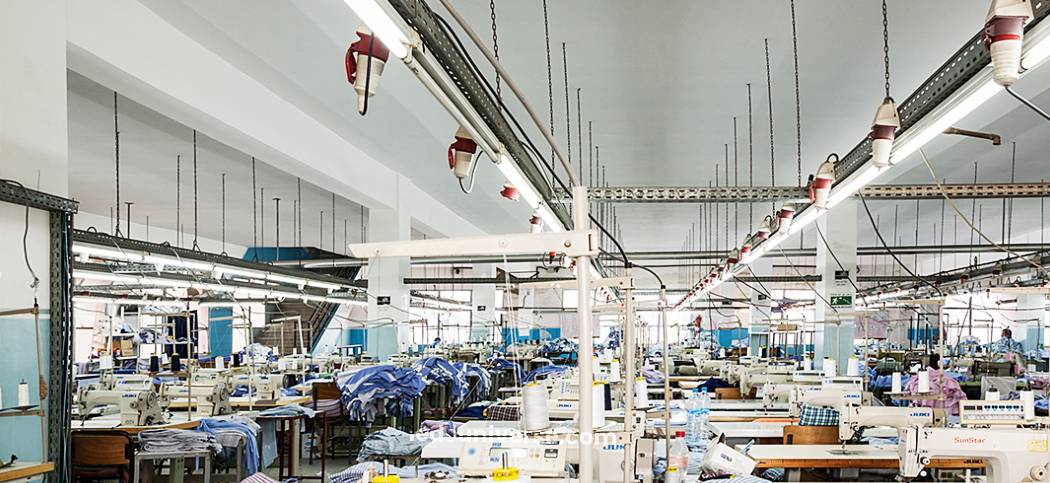Imagine a warehouse lit so perfectly that every corner is clear and shadow-free. Now think of the same space with dim, uneven light, making work harder. Discover how the right industrial lighting can boost safety, efficiency, and sustainability in your workspace. Ready to see the difference? Let’s dive in.
Industrial lighting influence extends from improving visibility and productivity to ensuring compliance with safety standards and reducing energy costs. This article delves into the various types of industrial lighting, their design considerations, safety and compliance aspects, and environmental impacts.
Reach out for free lighting consultation
Table of Contents
Toggle
High bay lighting is designed for spaces with high ceilings, typically ranging from 15 to 50 feet. It is commonly used in warehouses, manufacturing facilities, and large retail spaces. The fixtures for high bay lighting are engineered to provide broad, intense illumination to ensure every corner of a vast space is well-lit.
LED high bay lights are increasingly popular due to their energy efficiency and long lifespan. These fixtures provide high-quality light with minimal energy consumption, making them a cost-effective choice for large-scale industrial environments. Metal halide high bay lights, although less common now, offer high lumen output and are suitable for areas requiring very bright illumination.
Low bay lighting, in contrast, is suited for spaces with lower ceiling heights, typically under 15 feet. It is frequently used in smaller warehouses, workshops, and retail areas. The goal of low bay lighting is to provide uniform illumination over a more confined space.
Fluorescent fixtures have been a traditional choice for low bay lighting due to their relatively low cost and effective light distribution. However, LED technology has increasingly taken precedence due to its superior energy efficiency, reduced maintenance needs, and longer operational life.
Explosion-proof lighting is designed for use in hazardous environments where the risk of explosions due to flammable gases or dust is high. These fixtures are built to withstand explosions and prevent any ignition of hazardous substances within the environment.
These lights are subject to strict standards and regulations to ensure safety. They are typically constructed from durable materials such as heavy-duty metals and are sealed to prevent any entry of dust or moisture. Certification from agencies such as UL (Underwriters Laboratories) or ATEX (ATmosphères EXplosibles) is often required for explosion-proof lighting.
Flood lighting is utilized to illuminate large outdoor areas such as parking lots, building exteriors, and industrial yards. It provides wide-angle illumination, ensuring that expansive areas are covered uniformly.
LED floodlights are the preferred choice for many industrial applications due to their energy efficiency and high light output. High-intensity discharge (HID) floodlights are another option, though they are less commonly used today due to the advancement of LED technology.

The illuminance level, measured in lux, determines how much light is provided to a given area. Appropriate lux levels are vital to ensure that the work environment is well-lit for various tasks. Different industrial applications have specific requirements for illuminance, which can range from general illumination in large spaces to focused lighting for detailed work.
Adhering to industry standards and guidelines helps in determining the optimal illuminance levels. For instance, warehouses might require between 200 to 300 lux, while manufacturing areas with intricate tasks may need up to 1000 lux. Ensuring that these standards are met is crucial for maintaining a productive and safe work environment.
Uniform lighting is key to eliminating shadows and creating an evenly illuminated workspace. Inadequate uniformity can lead to uneven lighting, which may cause eyestrain and reduce productivity. Properly designed lighting systems minimize variations in light intensity across a space, creating a more comfortable and efficient work environment.
Glare reduction is another important factor. Glare can cause visual discomfort and impair visibility. Techniques such as using diffusers, selecting fixtures with appropriate beam angles, and ensuring proper fixture placement help in mitigating glare and improving overall lighting quality.
Energy efficiency is a significant consideration in industrial lighting, not only for cost savings but also for environmental impact. LED lighting has become the standard due to its low energy consumption compared to traditional lighting technologies such as incandescent or fluorescent lamps.
Energy-efficient lighting solutions also contribute to lower operational costs and reduced carbon footprints. Implementing advanced control systems, such as motion sensors and dimmers, further enhances energy savings by adjusting light levels based on occupancy and activity.
Durability is a key attribute for industrial lighting, as fixtures are often subjected to harsh conditions, including dust, moisture, and physical impacts. High-quality materials and robust construction ensure that the lighting systems withstand these conditions and provide reliable performance.
Maintenance requirements are also a crucial consideration. Fixtures with longer lifespans and fewer maintenance needs reduce the frequency of replacements and repairs. Regular inspection and upkeep are essential to maintaining optimal lighting performance and ensuring that any potential issues are addressed promptly.
In industrial settings, tailoring lighting to specific work areas can greatly enhance productivity and safety. For example, in areas where detailed assembly or inspection is performed, task lighting with high color rendering index (CRI) can help workers see fine details more clearly. Conversely, general areas such as hallways or storage rooms may benefit from more diffuse lighting that provides uniform illumination without causing discomfort. Customizing lighting solutions to the tasks performed in each area ensures that every part of the workspace is optimally lit for its intended purpose.
Adjustable lighting solutions provide flexibility in workspaces by allowing users to modify light intensity and direction based on specific needs. Task lights with adjustable arms or dimmable features can be used in areas where lighting requirements change frequently. This adaptability helps accommodate various tasks and preferences, leading to a more comfortable and productive working environment. Adjustable lighting also supports activities that require different lighting conditions, such as detailed work versus general illumination.
Industrial lighting must comply with various safety standards and regulations to ensure safe operation and prevent hazards. Organizations such as OSHA (Occupational Safety and Health Administration) and ANSI (American National Standards Institute) provide guidelines that help in designing and implementing safe lighting systems.
These standards cover aspects such as illuminance levels, fixture installation, and maintenance procedures. Adhering to these regulations not only ensures safety but also helps in avoiding potential legal issues and penalties.

Emergency lighting systems are designed to provide illumination in case of power outages or other emergencies. They are crucial for ensuring that employees can safely navigate the workspace during emergencies and for meeting safety regulations.
These systems typically include backup power sources, such as batteries or generators, to ensure that lights remain operational even during power failures. Proper installation and regular testing of emergency lighting systems are essential to ensure their reliability when needed.
Lighting conditions can have a profound impact on employee well-being, affecting both psychological and physical health. Studies have shown that well-designed lighting can enhance mood, reduce stress, and improve overall job satisfaction. In industrial settings, where workers may spend long hours in controlled environments, optimizing lighting to create a comfortable and visually pleasant workspace can contribute to better mental health and job performance.
Proper lighting helps reduce eye strain and fatigue, which are common issues in industrial settings with inadequate or harsh lighting. Adjustable lighting solutions that provide the right amount of illumination for specific tasks can help alleviate these problems. Additionally, incorporating lighting that mimics natural daylight can help regulate circadian rhythms, leading to improved alertness and comfort for employees.
Effective industrial lighting significantly influences worker efficiency and performance. Proper illumination reduces eye strain and fatigue, allowing employees to work more comfortably and effectively. In environments such as assembly lines or manufacturing floors, clear visibility is necessary for performing tasks accurately and safely. Bright, uniform lighting ensures that workers can see fine details and avoid errors, which ultimately enhances overall productivity.
Quality control processes benefit greatly from optimal lighting conditions. In industries where precision and detail are paramount, such as electronics or pharmaceuticals, high-quality lighting helps inspectors and workers examine products more thoroughly. Adequate lighting helps in detecting defects and ensuring that products meet stringent quality standards. This reduces the likelihood of costly rework and rejects, contributing to improved product quality and operational efficiency.
Cold storage facilities, such as those used for food preservation or pharmaceuticals, have unique lighting requirements due to their low-temperature environments. Lighting solutions for these spaces must be designed to perform reliably in extremely cold conditions. LED fixtures are often preferred for their durability and ability to operate efficiently at low temperatures. Additionally, these lights are resistant to the condensation and icing that can occur in cold storage areas, ensuring consistent performance and safety.
In hazardous environments where the risk of explosions or chemical reactions exists, lighting systems must meet stringent safety standards. Explosion-proof lighting is specifically engineered to prevent igniting flammable substances. These fixtures are constructed with robust materials and sealed to protect against dust, moisture, and impact. Ensuring that lighting solutions are properly certified and installed in compliance with safety regulations is vital for maintaining a safe operational environment.
Reducing energy consumption is a primary goal in modern industrial lighting design. Energy-efficient technologies, such as LED lights and advanced control systems, contribute significantly to lowering energy use.
Implementing energy-efficient lighting not only reduces operational costs but also aligns with broader sustainability goals. It helps in minimizing the environmental impact of industrial operations and supports initiatives for reducing greenhouse gas emissions.
Industrial lighting should also be designed to minimize light pollution, which can negatively impact surrounding environments and communities. Properly shielded fixtures and careful lighting design can prevent light from spilling into undesired areas, such as neighboring properties or the night sky. Addressing light pollution contributes to maintaining ecological balance and improving the quality of life in nearby areas.
Proper disposal and recycling of lighting fixtures and bulbs are important for environmental sustainability. Many lighting products contain materials that can be hazardous if not disposed of correctly.
Recycling programs and initiatives are available to handle the disposal of lighting components in an environmentally friendly manner. Adhering to these programs ensures that materials are reused or safely processed, reducing their impact on the environment.
In the realm of industrial lighting, thoughtful selection and implementation of lighting solutions contribute to enhanced safety, efficiency, and sustainability. By considering various types of lighting, design factors, and compliance requirements, industrial environments can achieve optimal lighting conditions that support both operational and environmental goals.
Maintaining industrial lighting systems involves regular inspections and upkeep to ensure continued performance and reliability. Routine maintenance includes cleaning fixtures to remove dust and debris, checking for any signs of wear or damage, and replacing faulty components. Establishing a maintenance schedule helps prevent unexpected failures and extends the lifespan of lighting fixtures.
Lifecycle management of lighting systems involves evaluating the total cost of ownership over time. This includes not only the initial installation costs but also ongoing maintenance, energy consumption, and eventual disposal. Opting for durable and energy-efficient lighting solutions can lead to significant long-term savings and reduced environmental impact. Planning for the end-of-life disposal or recycling of lighting products is also part of effective lifecycle management.
Industrial lighting should be integrated seamlessly with the building’s architectural design to enhance both functionality and aesthetics. Well-designed lighting can accentuate architectural features, create a pleasant working environment, and contribute to the overall visual appeal of the space. Coordinating lighting design with architectural elements ensures that lighting not only meets functional needs but also complements the building’s design.
As industries evolve and grow, their lighting needs may change. It is important to plan for future flexibility when designing lighting systems. Modular and adjustable lighting solutions allow for easy reconfiguration and upgrades as requirements shift. Incorporating adaptable lighting designs can accommodate changes in workspace layout or operational needs without requiring a complete overhaul of the lighting system.
The initial investment in industrial lighting systems can be substantial, especially when upgrading to advanced technologies such as LEDs or smart lighting. However, conducting a thorough cost-benefit analysis can reveal significant long-term savings. By comparing the upfront costs with potential reductions in energy consumption and maintenance expenses, businesses can make informed decisions about their lighting investments. Evaluating factors such as the return on investment (ROI) and payback period helps in understanding the financial benefits of modernizing lighting systems.
To offset the costs of upgrading industrial lighting, businesses can explore various financial incentives and rebates. Many governments, utilities, and environmental organizations offer programs designed to support energy-efficient upgrades. These incentives can include direct rebates, tax credits, or grants that reduce the overall cost of new lighting installations. Researching and applying for these financial aids can make high-efficiency lighting solutions more accessible and economically viable.

Grants can be a valuable resource for businesses and organizations looking to upgrade their industrial lighting systems. These financial aids are often provided by government agencies, non-profit organizations, and utility companies to support energy-efficient upgrades and enhance safety and sustainability. Securing a grant can help offset the costs associated with installing advanced lighting solutions and can make it more feasible to implement comprehensive lighting improvements.
Various government programs are designed to promote energy efficiency and sustainability within industrial sectors. These programs often offer grants or financial incentives to support the installation of energy-efficient lighting systems. For instance, the U.S. Department of Energy (DOE) offers several grant opportunities through its various programs focused on improving energy efficiency in industrial operations. Businesses may also find local and state-level grants aimed at supporting energy-efficient upgrades.
Many utility companies provide rebates and incentives for businesses that invest in energy-efficient lighting solutions. These rebates can significantly reduce the upfront costs of upgrading to LED or other high-efficiency lighting technologies. Utility companies often collaborate with energy efficiency programs to offer these incentives, encouraging businesses to adopt solutions that lower energy consumption and reduce overall energy costs.
Several non-profit organizations focus on promoting energy efficiency and sustainability. These organizations may offer grants or funding opportunities for industrial lighting projects that align with their goals. For example, organizations such as the Energy Foundation or the National Resource Defense Council (NRDC) may have programs that provide financial support or technical assistance for implementing energy-efficient lighting systems.
Applying for grants involves several steps, including identifying suitable grant opportunities, preparing required documentation, and submitting applications. Businesses should thoroughly research available grants to find those that match their project needs and eligibility criteria.
The application process typically requires detailed information about the proposed lighting project, including technical specifications, estimated costs, and projected energy savings. It may also involve demonstrating how the project aligns with the grantor’s objectives, such as improving energy efficiency or enhancing safety.
Receiving a grant for an industrial lighting project can provide several benefits beyond financial assistance. Grants can facilitate access to advanced lighting technologies that might otherwise be cost-prohibitive. They can also contribute to achieving sustainability goals and improving overall operational efficiency.
In addition to the immediate financial advantages, implementing energy-efficient lighting solutions can lead to long-term cost savings through reduced energy bills and lower maintenance costs. Grants may also help businesses meet regulatory requirements or industry standards, further enhancing operational compliance and safety.
Industrial lighting encompasses a diverse range of solutions tailored to various applications and environments. Understanding the types of lighting available, such as high bay, low bay, explosion-proof, and flood lighting, is crucial for selecting the right fixtures for specific needs. Design considerations, including illuminance levels, uniformity, glare reduction, energy efficiency, and durability, play a significant role in creating an effective lighting system.
Safety and compliance are integral to industrial lighting, with adherence to standards and regulations ensuring a secure and functional environment. Additionally, addressing environmental and sustainability concerns through energy-efficient lighting and proper disposal practices supports broader sustainability goals.
Grants and financial incentives offer valuable support for upgrading industrial lighting systems, providing opportunities for businesses to implement advanced technologies and achieve significant benefits. By exploring available funding options and understanding their advantages, organizations can enhance their lighting systems, contributing to improved operational efficiency and long-term sustainability.